Report on Marketing Curriculum Design, Development, and Evaluation
VerifiedAdded on 2023/06/08
|32
|7149
|87
Report
AI Summary
This report delves into the critical aspects of marketing curriculum design and development. It begins by analyzing the purposes behind curriculum design, encompassing academic, social, economic, and political factors. The report then explores various approaches to curriculum design, including learner-centered, subject-centered, and problem-centered approaches, alongside a discussion of product and process models. The significance of learner feedback in curriculum development is emphasized, with a focus on risk management strategies. The report outlines methodologies for monitoring and evaluating a curriculum. Furthermore, the report outlines the design of a curriculum aligned with specific outcomes and objectives. It includes the development of a curriculum for an education and training program, assessment methods, and the production of supporting resources. Finally, the report evaluates the achievement of learning outcomes, analyzes curriculum delivery, identifies areas for improvement, and suggests enhancements for an education and training curriculum, concluding with an overall assessment and recommendations.
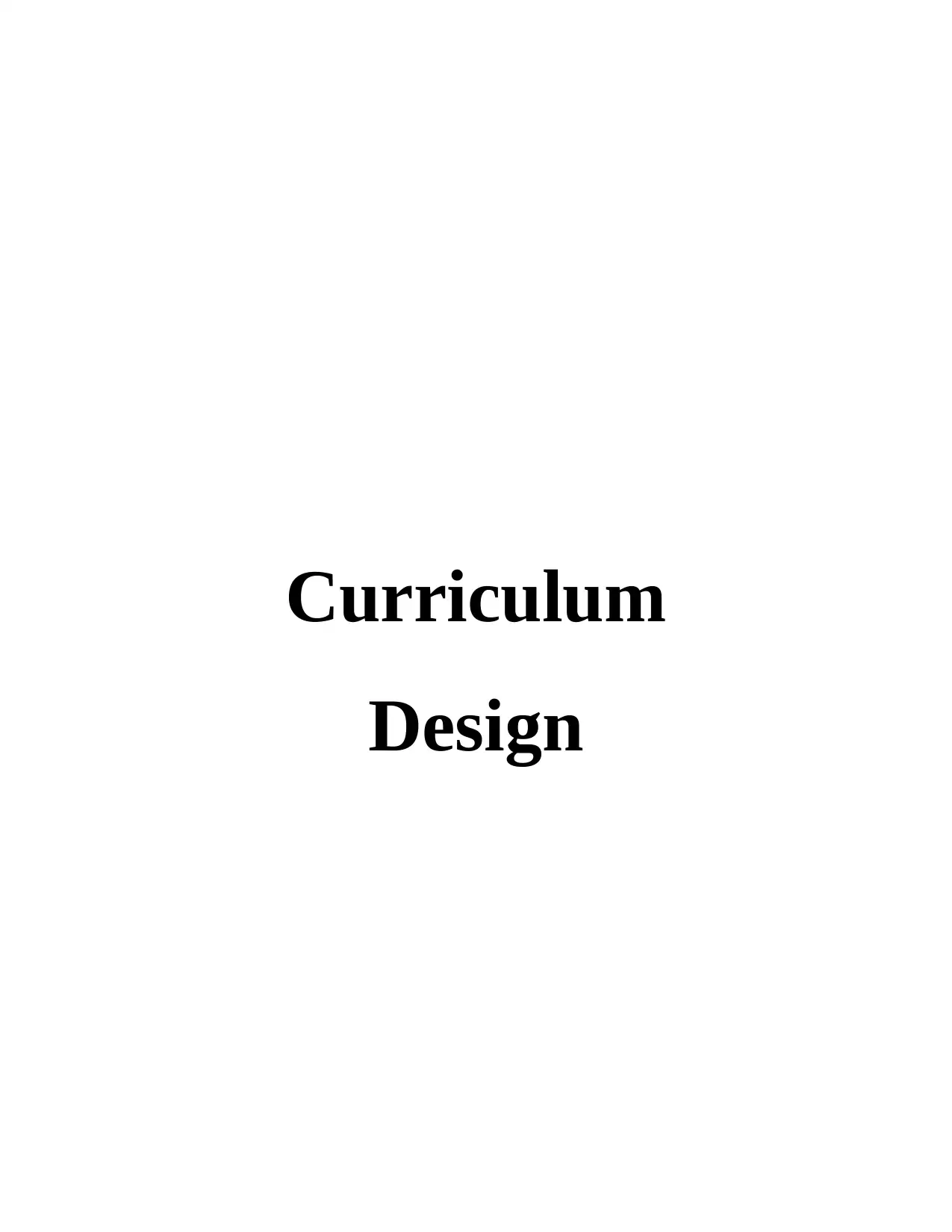
Curriculum
Design
Design
Paraphrase This Document
Need a fresh take? Get an instant paraphrase of this document with our AI Paraphraser
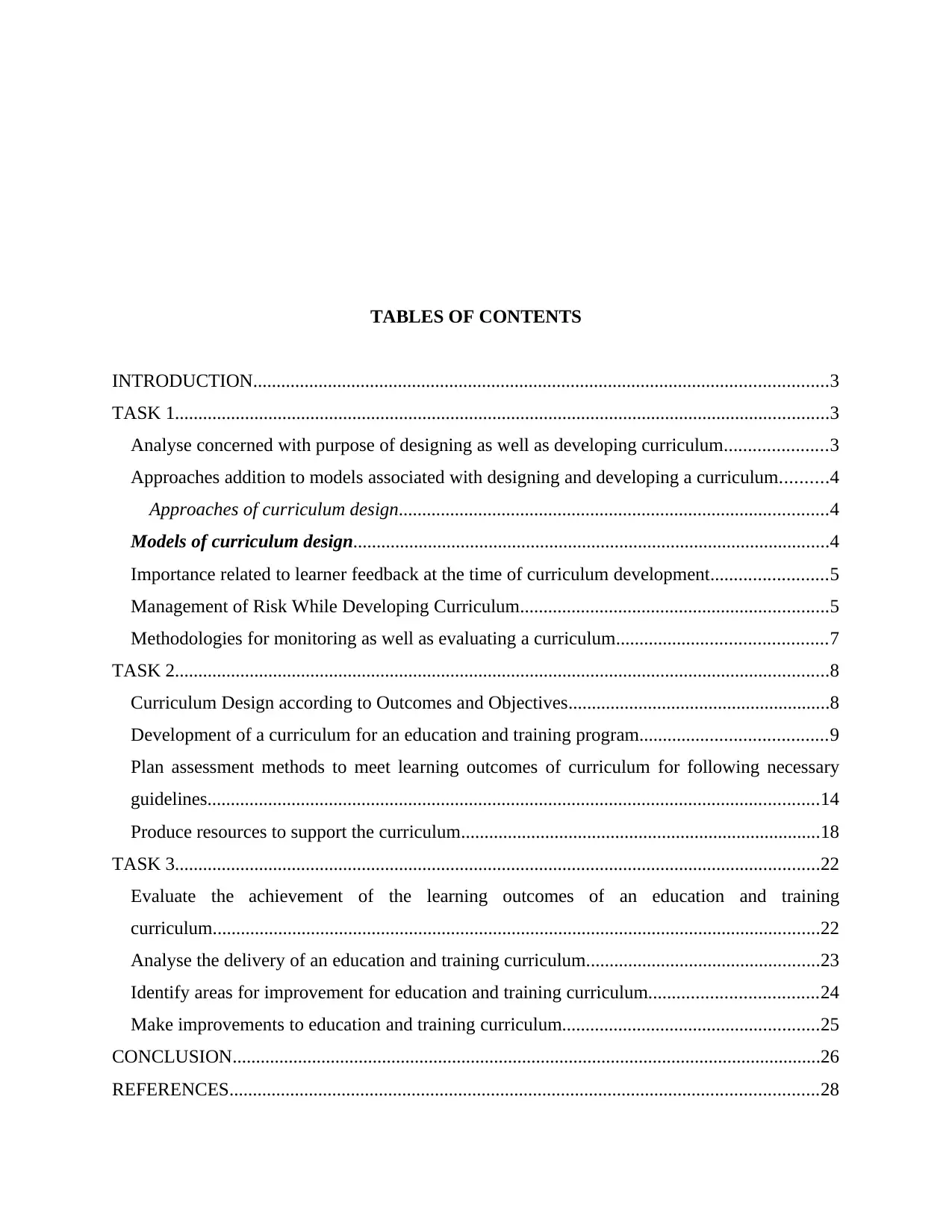
TABLES OF CONTENTS
INTRODUCTION...........................................................................................................................3
TASK 1............................................................................................................................................3
Analyse concerned with purpose of designing as well as developing curriculum......................3
Approaches addition to models associated with designing and developing a curriculum..........4
Approaches of curriculum design............................................................................................4
Models of curriculum design......................................................................................................4
Importance related to learner feedback at the time of curriculum development.........................5
Management of Risk While Developing Curriculum..................................................................5
Methodologies for monitoring as well as evaluating a curriculum.............................................7
TASK 2............................................................................................................................................8
Curriculum Design according to Outcomes and Objectives........................................................8
Development of a curriculum for an education and training program........................................9
Plan assessment methods to meet learning outcomes of curriculum for following necessary
guidelines...................................................................................................................................14
Produce resources to support the curriculum.............................................................................18
TASK 3..........................................................................................................................................22
Evaluate the achievement of the learning outcomes of an education and training
curriculum..................................................................................................................................22
Analyse the delivery of an education and training curriculum..................................................23
Identify areas for improvement for education and training curriculum....................................24
Make improvements to education and training curriculum.......................................................25
CONCLUSION..............................................................................................................................26
REFERENCES..............................................................................................................................28
INTRODUCTION...........................................................................................................................3
TASK 1............................................................................................................................................3
Analyse concerned with purpose of designing as well as developing curriculum......................3
Approaches addition to models associated with designing and developing a curriculum..........4
Approaches of curriculum design............................................................................................4
Models of curriculum design......................................................................................................4
Importance related to learner feedback at the time of curriculum development.........................5
Management of Risk While Developing Curriculum..................................................................5
Methodologies for monitoring as well as evaluating a curriculum.............................................7
TASK 2............................................................................................................................................8
Curriculum Design according to Outcomes and Objectives........................................................8
Development of a curriculum for an education and training program........................................9
Plan assessment methods to meet learning outcomes of curriculum for following necessary
guidelines...................................................................................................................................14
Produce resources to support the curriculum.............................................................................18
TASK 3..........................................................................................................................................22
Evaluate the achievement of the learning outcomes of an education and training
curriculum..................................................................................................................................22
Analyse the delivery of an education and training curriculum..................................................23
Identify areas for improvement for education and training curriculum....................................24
Make improvements to education and training curriculum.......................................................25
CONCLUSION..............................................................................................................................26
REFERENCES..............................................................................................................................28

⊘ This is a preview!⊘
Do you want full access?
Subscribe today to unlock all pages.

Trusted by 1+ million students worldwide
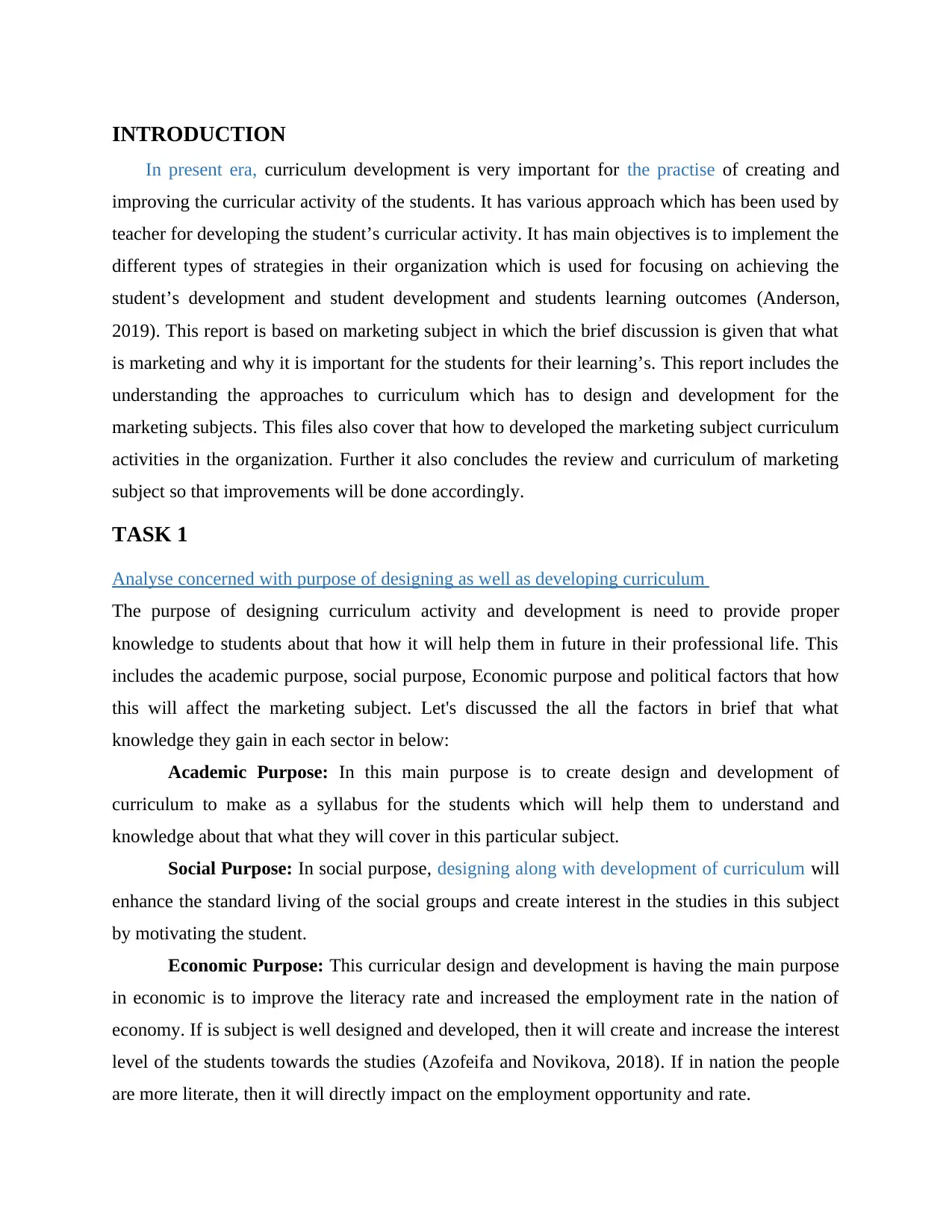
INTRODUCTION
In present era, curriculum development is very important for the practise of creating and
improving the curricular activity of the students. It has various approach which has been used by
teacher for developing the student’s curricular activity. It has main objectives is to implement the
different types of strategies in their organization which is used for focusing on achieving the
student’s development and student development and students learning outcomes (Anderson,
2019). This report is based on marketing subject in which the brief discussion is given that what
is marketing and why it is important for the students for their learning’s. This report includes the
understanding the approaches to curriculum which has to design and development for the
marketing subjects. This files also cover that how to developed the marketing subject curriculum
activities in the organization. Further it also concludes the review and curriculum of marketing
subject so that improvements will be done accordingly.
TASK 1
Analyse concerned with purpose of designing as well as developing curriculum
The purpose of designing curriculum activity and development is need to provide proper
knowledge to students about that how it will help them in future in their professional life. This
includes the academic purpose, social purpose, Economic purpose and political factors that how
this will affect the marketing subject. Let's discussed the all the factors in brief that what
knowledge they gain in each sector in below:
Academic Purpose: In this main purpose is to create design and development of
curriculum to make as a syllabus for the students which will help them to understand and
knowledge about that what they will cover in this particular subject.
Social Purpose: In social purpose, designing along with development of curriculum will
enhance the standard living of the social groups and create interest in the studies in this subject
by motivating the student.
Economic Purpose: This curricular design and development is having the main purpose
in economic is to improve the literacy rate and increased the employment rate in the nation of
economy. If is subject is well designed and developed, then it will create and increase the interest
level of the students towards the studies (Azofeifa and Novikova, 2018). If in nation the people
are more literate, then it will directly impact on the employment opportunity and rate.
In present era, curriculum development is very important for the practise of creating and
improving the curricular activity of the students. It has various approach which has been used by
teacher for developing the student’s curricular activity. It has main objectives is to implement the
different types of strategies in their organization which is used for focusing on achieving the
student’s development and student development and students learning outcomes (Anderson,
2019). This report is based on marketing subject in which the brief discussion is given that what
is marketing and why it is important for the students for their learning’s. This report includes the
understanding the approaches to curriculum which has to design and development for the
marketing subjects. This files also cover that how to developed the marketing subject curriculum
activities in the organization. Further it also concludes the review and curriculum of marketing
subject so that improvements will be done accordingly.
TASK 1
Analyse concerned with purpose of designing as well as developing curriculum
The purpose of designing curriculum activity and development is need to provide proper
knowledge to students about that how it will help them in future in their professional life. This
includes the academic purpose, social purpose, Economic purpose and political factors that how
this will affect the marketing subject. Let's discussed the all the factors in brief that what
knowledge they gain in each sector in below:
Academic Purpose: In this main purpose is to create design and development of
curriculum to make as a syllabus for the students which will help them to understand and
knowledge about that what they will cover in this particular subject.
Social Purpose: In social purpose, designing along with development of curriculum will
enhance the standard living of the social groups and create interest in the studies in this subject
by motivating the student.
Economic Purpose: This curricular design and development is having the main purpose
in economic is to improve the literacy rate and increased the employment rate in the nation of
economy. If is subject is well designed and developed, then it will create and increase the interest
level of the students towards the studies (Azofeifa and Novikova, 2018). If in nation the people
are more literate, then it will directly impact on the employment opportunity and rate.
Paraphrase This Document
Need a fresh take? Get an instant paraphrase of this document with our AI Paraphraser
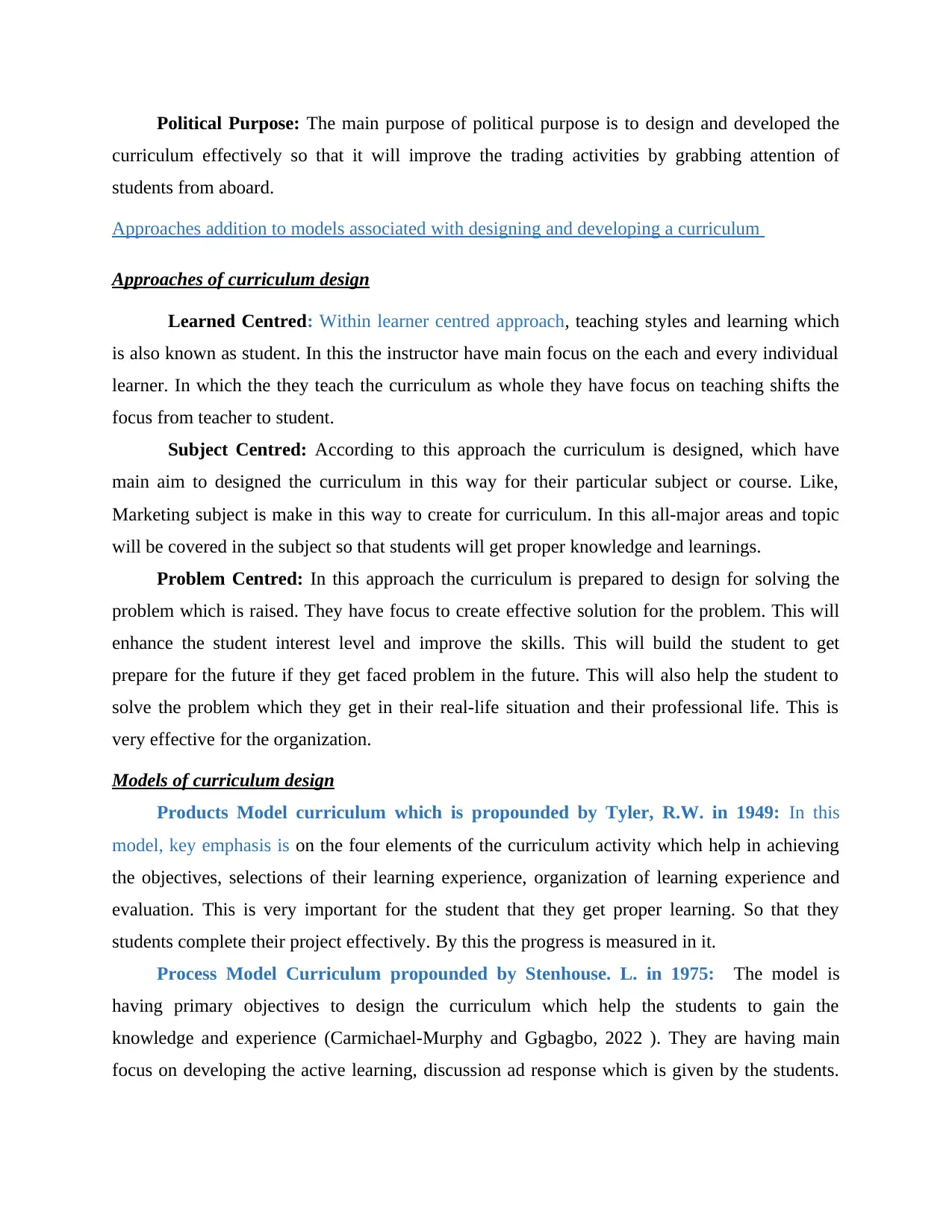
Political Purpose: The main purpose of political purpose is to design and developed the
curriculum effectively so that it will improve the trading activities by grabbing attention of
students from aboard.
Approaches addition to models associated with designing and developing a curriculum
Approaches of curriculum design
Learned Centred: Within learner centred approach, teaching styles and learning which
is also known as student. In this the instructor have main focus on the each and every individual
learner. In which the they teach the curriculum as whole they have focus on teaching shifts the
focus from teacher to student.
Subject Centred: According to this approach the curriculum is designed, which have
main aim to designed the curriculum in this way for their particular subject or course. Like,
Marketing subject is make in this way to create for curriculum. In this all-major areas and topic
will be covered in the subject so that students will get proper knowledge and learnings.
Problem Centred: In this approach the curriculum is prepared to design for solving the
problem which is raised. They have focus to create effective solution for the problem. This will
enhance the student interest level and improve the skills. This will build the student to get
prepare for the future if they get faced problem in the future. This will also help the student to
solve the problem which they get in their real-life situation and their professional life. This is
very effective for the organization.
Models of curriculum design
Products Model curriculum which is propounded by Tyler, R.W. in 1949: In this
model, key emphasis is on the four elements of the curriculum activity which help in achieving
the objectives, selections of their learning experience, organization of learning experience and
evaluation. This is very important for the student that they get proper learning. So that they
students complete their project effectively. By this the progress is measured in it.
Process Model Curriculum propounded by Stenhouse. L. in 1975: The model is
having primary objectives to design the curriculum which help the students to gain the
knowledge and experience (Carmichael-Murphy and Ggbagbo, 2022 ). They are having main
focus on developing the active learning, discussion ad response which is given by the students.
curriculum effectively so that it will improve the trading activities by grabbing attention of
students from aboard.
Approaches addition to models associated with designing and developing a curriculum
Approaches of curriculum design
Learned Centred: Within learner centred approach, teaching styles and learning which
is also known as student. In this the instructor have main focus on the each and every individual
learner. In which the they teach the curriculum as whole they have focus on teaching shifts the
focus from teacher to student.
Subject Centred: According to this approach the curriculum is designed, which have
main aim to designed the curriculum in this way for their particular subject or course. Like,
Marketing subject is make in this way to create for curriculum. In this all-major areas and topic
will be covered in the subject so that students will get proper knowledge and learnings.
Problem Centred: In this approach the curriculum is prepared to design for solving the
problem which is raised. They have focus to create effective solution for the problem. This will
enhance the student interest level and improve the skills. This will build the student to get
prepare for the future if they get faced problem in the future. This will also help the student to
solve the problem which they get in their real-life situation and their professional life. This is
very effective for the organization.
Models of curriculum design
Products Model curriculum which is propounded by Tyler, R.W. in 1949: In this
model, key emphasis is on the four elements of the curriculum activity which help in achieving
the objectives, selections of their learning experience, organization of learning experience and
evaluation. This is very important for the student that they get proper learning. So that they
students complete their project effectively. By this the progress is measured in it.
Process Model Curriculum propounded by Stenhouse. L. in 1975: The model is
having primary objectives to design the curriculum which help the students to gain the
knowledge and experience (Carmichael-Murphy and Ggbagbo, 2022 ). They are having main
focus on developing the active learning, discussion ad response which is given by the students.
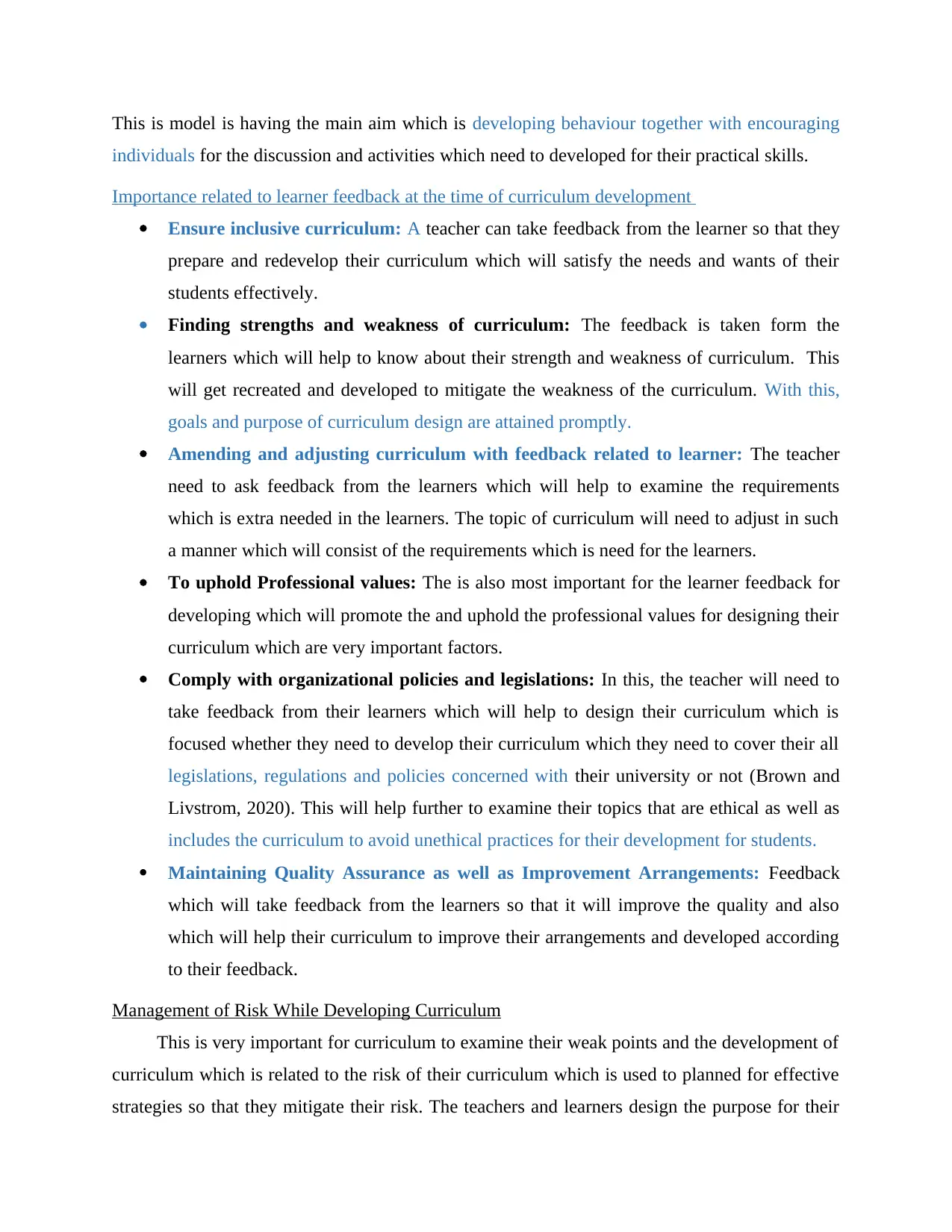
This is model is having the main aim which is developing behaviour together with encouraging
individuals for the discussion and activities which need to developed for their practical skills.
Importance related to learner feedback at the time of curriculum development
Ensure inclusive curriculum: A teacher can take feedback from the learner so that they
prepare and redevelop their curriculum which will satisfy the needs and wants of their
students effectively.
Finding strengths and weakness of curriculum: The feedback is taken form the
learners which will help to know about their strength and weakness of curriculum. This
will get recreated and developed to mitigate the weakness of the curriculum. With this,
goals and purpose of curriculum design are attained promptly.
Amending and adjusting curriculum with feedback related to learner: The teacher
need to ask feedback from the learners which will help to examine the requirements
which is extra needed in the learners. The topic of curriculum will need to adjust in such
a manner which will consist of the requirements which is need for the learners.
To uphold Professional values: The is also most important for the learner feedback for
developing which will promote the and uphold the professional values for designing their
curriculum which are very important factors.
Comply with organizational policies and legislations: In this, the teacher will need to
take feedback from their learners which will help to design their curriculum which is
focused whether they need to develop their curriculum which they need to cover their all
legislations, regulations and policies concerned with their university or not (Brown and
Livstrom, 2020). This will help further to examine their topics that are ethical as well as
includes the curriculum to avoid unethical practices for their development for students.
Maintaining Quality Assurance as well as Improvement Arrangements: Feedback
which will take feedback from the learners so that it will improve the quality and also
which will help their curriculum to improve their arrangements and developed according
to their feedback.
Management of Risk While Developing Curriculum
This is very important for curriculum to examine their weak points and the development of
curriculum which is related to the risk of their curriculum which is used to planned for effective
strategies so that they mitigate their risk. The teachers and learners design the purpose for their
individuals for the discussion and activities which need to developed for their practical skills.
Importance related to learner feedback at the time of curriculum development
Ensure inclusive curriculum: A teacher can take feedback from the learner so that they
prepare and redevelop their curriculum which will satisfy the needs and wants of their
students effectively.
Finding strengths and weakness of curriculum: The feedback is taken form the
learners which will help to know about their strength and weakness of curriculum. This
will get recreated and developed to mitigate the weakness of the curriculum. With this,
goals and purpose of curriculum design are attained promptly.
Amending and adjusting curriculum with feedback related to learner: The teacher
need to ask feedback from the learners which will help to examine the requirements
which is extra needed in the learners. The topic of curriculum will need to adjust in such
a manner which will consist of the requirements which is need for the learners.
To uphold Professional values: The is also most important for the learner feedback for
developing which will promote the and uphold the professional values for designing their
curriculum which are very important factors.
Comply with organizational policies and legislations: In this, the teacher will need to
take feedback from their learners which will help to design their curriculum which is
focused whether they need to develop their curriculum which they need to cover their all
legislations, regulations and policies concerned with their university or not (Brown and
Livstrom, 2020). This will help further to examine their topics that are ethical as well as
includes the curriculum to avoid unethical practices for their development for students.
Maintaining Quality Assurance as well as Improvement Arrangements: Feedback
which will take feedback from the learners so that it will improve the quality and also
which will help their curriculum to improve their arrangements and developed according
to their feedback.
Management of Risk While Developing Curriculum
This is very important for curriculum to examine their weak points and the development of
curriculum which is related to the risk of their curriculum which is used to planned for effective
strategies so that they mitigate their risk. The teachers and learners design the purpose for their
⊘ This is a preview!⊘
Do you want full access?
Subscribe today to unlock all pages.

Trusted by 1+ million students worldwide
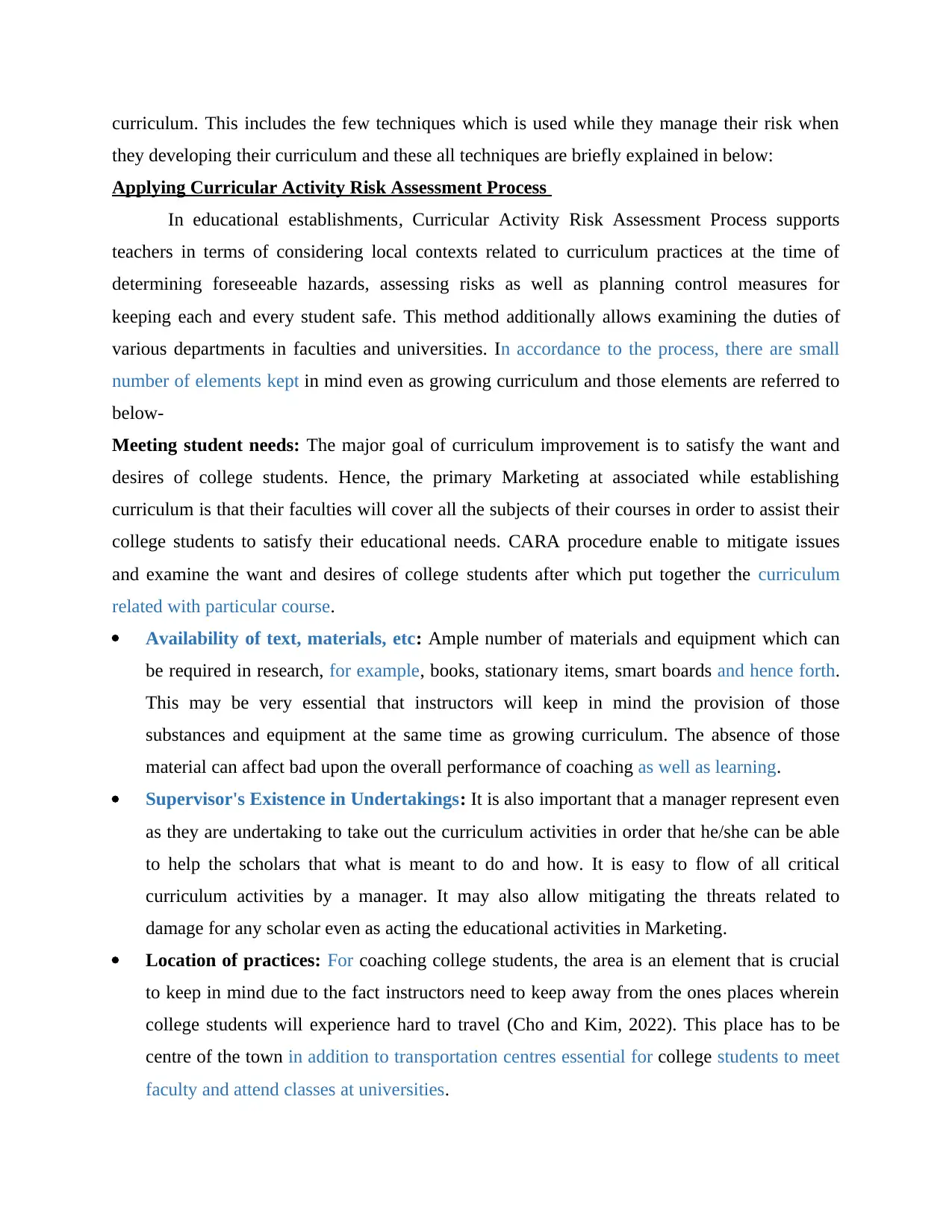
curriculum. This includes the few techniques which is used while they manage their risk when
they developing their curriculum and these all techniques are briefly explained in below:
Applying Curricular Activity Risk Assessment Process
In educational establishments, Curricular Activity Risk Assessment Process supports
teachers in terms of considering local contexts related to curriculum practices at the time of
determining foreseeable hazards, assessing risks as well as planning control measures for
keeping each and every student safe. This method additionally allows examining the duties of
various departments in faculties and universities. In accordance to the process, there are small
number of elements kept in mind even as growing curriculum and those elements are referred to
below-
Meeting student needs: The major goal of curriculum improvement is to satisfy the want and
desires of college students. Hence, the primary Marketing at associated while establishing
curriculum is that their faculties will cover all the subjects of their courses in order to assist their
college students to satisfy their educational needs. CARA procedure enable to mitigate issues
and examine the want and desires of college students after which put together the curriculum
related with particular course.
Availability of text, materials, etc: Ample number of materials and equipment which can
be required in research, for example, books, stationary items, smart boards and hence forth.
This may be very essential that instructors will keep in mind the provision of those
substances and equipment at the same time as growing curriculum. The absence of those
material can affect bad upon the overall performance of coaching as well as learning.
Supervisor's Existence in Undertakings: It is also important that a manager represent even
as they are undertaking to take out the curriculum activities in order that he/she can be able
to help the scholars that what is meant to do and how. It is easy to flow of all critical
curriculum activities by a manager. It may also allow mitigating the threats related to
damage for any scholar even as acting the educational activities in Marketing.
Location of practices: For coaching college students, the area is an element that is crucial
to keep in mind due to the fact instructors need to keep away from the ones places wherein
college students will experience hard to travel (Cho and Kim, 2022). This place has to be
centre of the town in addition to transportation centres essential for college students to meet
faculty and attend classes at universities.
they developing their curriculum and these all techniques are briefly explained in below:
Applying Curricular Activity Risk Assessment Process
In educational establishments, Curricular Activity Risk Assessment Process supports
teachers in terms of considering local contexts related to curriculum practices at the time of
determining foreseeable hazards, assessing risks as well as planning control measures for
keeping each and every student safe. This method additionally allows examining the duties of
various departments in faculties and universities. In accordance to the process, there are small
number of elements kept in mind even as growing curriculum and those elements are referred to
below-
Meeting student needs: The major goal of curriculum improvement is to satisfy the want and
desires of college students. Hence, the primary Marketing at associated while establishing
curriculum is that their faculties will cover all the subjects of their courses in order to assist their
college students to satisfy their educational needs. CARA procedure enable to mitigate issues
and examine the want and desires of college students after which put together the curriculum
related with particular course.
Availability of text, materials, etc: Ample number of materials and equipment which can
be required in research, for example, books, stationary items, smart boards and hence forth.
This may be very essential that instructors will keep in mind the provision of those
substances and equipment at the same time as growing curriculum. The absence of those
material can affect bad upon the overall performance of coaching as well as learning.
Supervisor's Existence in Undertakings: It is also important that a manager represent even
as they are undertaking to take out the curriculum activities in order that he/she can be able
to help the scholars that what is meant to do and how. It is easy to flow of all critical
curriculum activities by a manager. It may also allow mitigating the threats related to
damage for any scholar even as acting the educational activities in Marketing.
Location of practices: For coaching college students, the area is an element that is crucial
to keep in mind due to the fact instructors need to keep away from the ones places wherein
college students will experience hard to travel (Cho and Kim, 2022). This place has to be
centre of the town in addition to transportation centres essential for college students to meet
faculty and attend classes at universities.
Paraphrase This Document
Need a fresh take? Get an instant paraphrase of this document with our AI Paraphraser
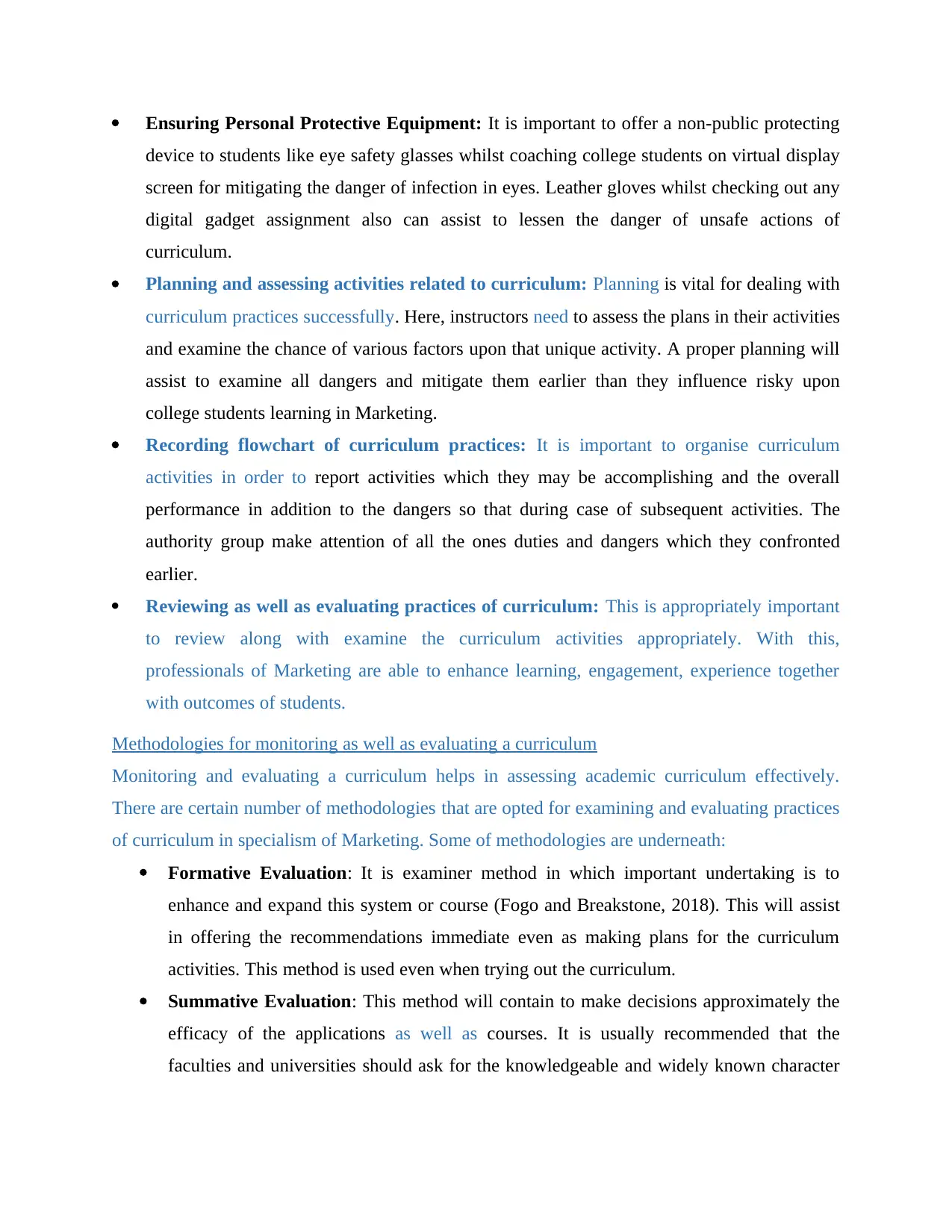
Ensuring Personal Protective Equipment: It is important to offer a non-public protecting
device to students like eye safety glasses whilst coaching college students on virtual display
screen for mitigating the danger of infection in eyes. Leather gloves whilst checking out any
digital gadget assignment also can assist to lessen the danger of unsafe actions of
curriculum.
Planning and assessing activities related to curriculum: Planning is vital for dealing with
curriculum practices successfully. Here, instructors need to assess the plans in their activities
and examine the chance of various factors upon that unique activity. A proper planning will
assist to examine all dangers and mitigate them earlier than they influence risky upon
college students learning in Marketing.
Recording flowchart of curriculum practices: It is important to organise curriculum
activities in order to report activities which they may be accomplishing and the overall
performance in addition to the dangers so that during case of subsequent activities. The
authority group make attention of all the ones duties and dangers which they confronted
earlier.
Reviewing as well as evaluating practices of curriculum: This is appropriately important
to review along with examine the curriculum activities appropriately. With this,
professionals of Marketing are able to enhance learning, engagement, experience together
with outcomes of students.
Methodologies for monitoring as well as evaluating a curriculum
Monitoring and evaluating a curriculum helps in assessing academic curriculum effectively.
There are certain number of methodologies that are opted for examining and evaluating practices
of curriculum in specialism of Marketing. Some of methodologies are underneath:
Formative Evaluation: It is examiner method in which important undertaking is to
enhance and expand this system or course (Fogo and Breakstone, 2018). This will assist
in offering the recommendations immediate even as making plans for the curriculum
activities. This method is used even when trying out the curriculum.
Summative Evaluation: This method will contain to make decisions approximately the
efficacy of the applications as well as courses. It is usually recommended that the
faculties and universities should ask for the knowledgeable and widely known character
device to students like eye safety glasses whilst coaching college students on virtual display
screen for mitigating the danger of infection in eyes. Leather gloves whilst checking out any
digital gadget assignment also can assist to lessen the danger of unsafe actions of
curriculum.
Planning and assessing activities related to curriculum: Planning is vital for dealing with
curriculum practices successfully. Here, instructors need to assess the plans in their activities
and examine the chance of various factors upon that unique activity. A proper planning will
assist to examine all dangers and mitigate them earlier than they influence risky upon
college students learning in Marketing.
Recording flowchart of curriculum practices: It is important to organise curriculum
activities in order to report activities which they may be accomplishing and the overall
performance in addition to the dangers so that during case of subsequent activities. The
authority group make attention of all the ones duties and dangers which they confronted
earlier.
Reviewing as well as evaluating practices of curriculum: This is appropriately important
to review along with examine the curriculum activities appropriately. With this,
professionals of Marketing are able to enhance learning, engagement, experience together
with outcomes of students.
Methodologies for monitoring as well as evaluating a curriculum
Monitoring and evaluating a curriculum helps in assessing academic curriculum effectively.
There are certain number of methodologies that are opted for examining and evaluating practices
of curriculum in specialism of Marketing. Some of methodologies are underneath:
Formative Evaluation: It is examiner method in which important undertaking is to
enhance and expand this system or course (Fogo and Breakstone, 2018). This will assist
in offering the recommendations immediate even as making plans for the curriculum
activities. This method is used even when trying out the curriculum.
Summative Evaluation: This method will contain to make decisions approximately the
efficacy of the applications as well as courses. It is usually recommended that the
faculties and universities should ask for the knowledgeable and widely known character
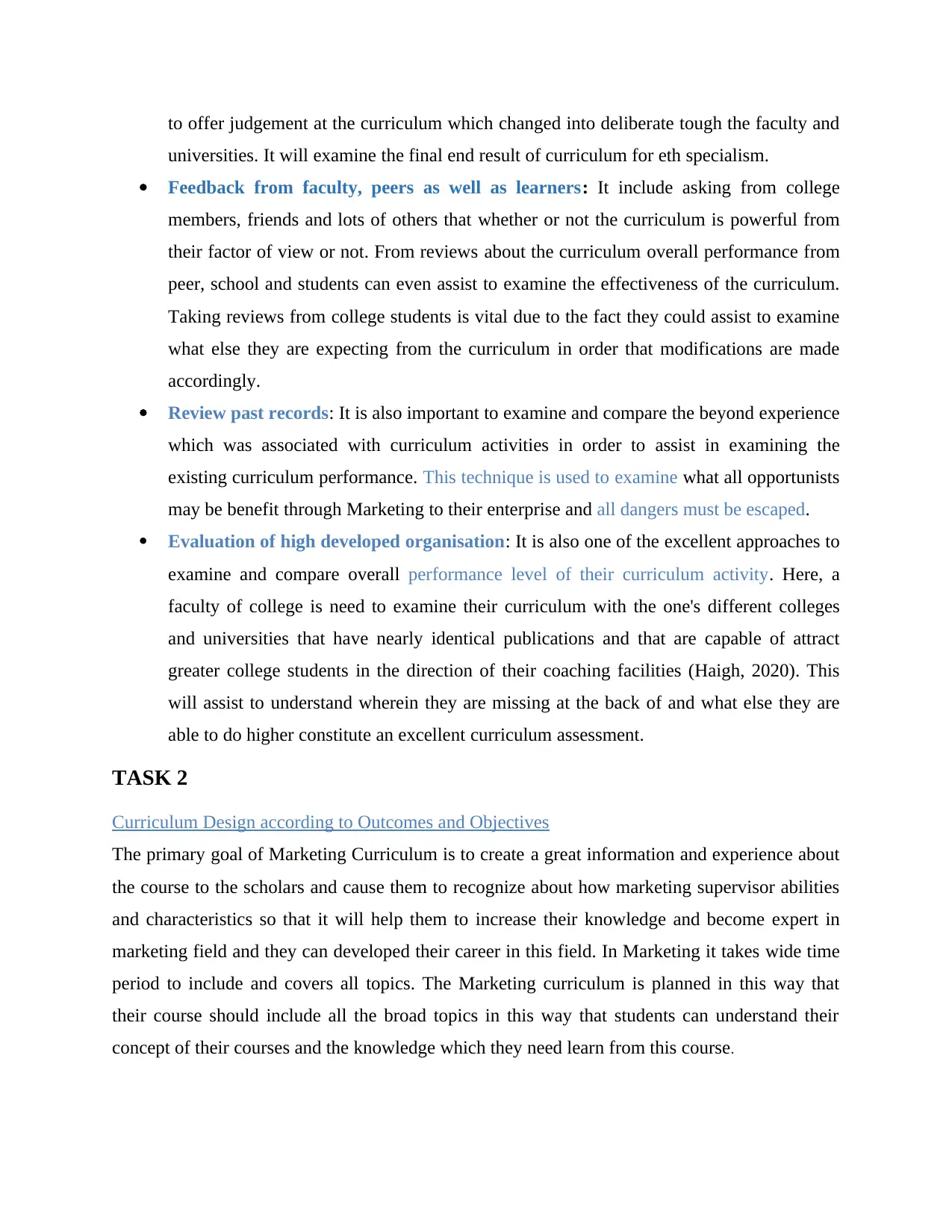
to offer judgement at the curriculum which changed into deliberate tough the faculty and
universities. It will examine the final end result of curriculum for eth specialism.
Feedback from faculty, peers as well as learners: It include asking from college
members, friends and lots of others that whether or not the curriculum is powerful from
their factor of view or not. From reviews about the curriculum overall performance from
peer, school and students can even assist to examine the effectiveness of the curriculum.
Taking reviews from college students is vital due to the fact they could assist to examine
what else they are expecting from the curriculum in order that modifications are made
accordingly.
Review past records: It is also important to examine and compare the beyond experience
which was associated with curriculum activities in order to assist in examining the
existing curriculum performance. This technique is used to examine what all opportunists
may be benefit through Marketing to their enterprise and all dangers must be escaped.
Evaluation of high developed organisation: It is also one of the excellent approaches to
examine and compare overall performance level of their curriculum activity. Here, a
faculty of college is need to examine their curriculum with the one's different colleges
and universities that have nearly identical publications and that are capable of attract
greater college students in the direction of their coaching facilities (Haigh, 2020). This
will assist to understand wherein they are missing at the back of and what else they are
able to do higher constitute an excellent curriculum assessment.
TASK 2
Curriculum Design according to Outcomes and Objectives
The primary goal of Marketing Curriculum is to create a great information and experience about
the course to the scholars and cause them to recognize about how marketing supervisor abilities
and characteristics so that it will help them to increase their knowledge and become expert in
marketing field and they can developed their career in this field. In Marketing it takes wide time
period to include and covers all topics. The Marketing curriculum is planned in this way that
their course should include all the broad topics in this way that students can understand their
concept of their courses and the knowledge which they need learn from this course.
universities. It will examine the final end result of curriculum for eth specialism.
Feedback from faculty, peers as well as learners: It include asking from college
members, friends and lots of others that whether or not the curriculum is powerful from
their factor of view or not. From reviews about the curriculum overall performance from
peer, school and students can even assist to examine the effectiveness of the curriculum.
Taking reviews from college students is vital due to the fact they could assist to examine
what else they are expecting from the curriculum in order that modifications are made
accordingly.
Review past records: It is also important to examine and compare the beyond experience
which was associated with curriculum activities in order to assist in examining the
existing curriculum performance. This technique is used to examine what all opportunists
may be benefit through Marketing to their enterprise and all dangers must be escaped.
Evaluation of high developed organisation: It is also one of the excellent approaches to
examine and compare overall performance level of their curriculum activity. Here, a
faculty of college is need to examine their curriculum with the one's different colleges
and universities that have nearly identical publications and that are capable of attract
greater college students in the direction of their coaching facilities (Haigh, 2020). This
will assist to understand wherein they are missing at the back of and what else they are
able to do higher constitute an excellent curriculum assessment.
TASK 2
Curriculum Design according to Outcomes and Objectives
The primary goal of Marketing Curriculum is to create a great information and experience about
the course to the scholars and cause them to recognize about how marketing supervisor abilities
and characteristics so that it will help them to increase their knowledge and become expert in
marketing field and they can developed their career in this field. In Marketing it takes wide time
period to include and covers all topics. The Marketing curriculum is planned in this way that
their course should include all the broad topics in this way that students can understand their
concept of their courses and the knowledge which they need learn from this course.
⊘ This is a preview!⊘
Do you want full access?
Subscribe today to unlock all pages.

Trusted by 1+ million students worldwide
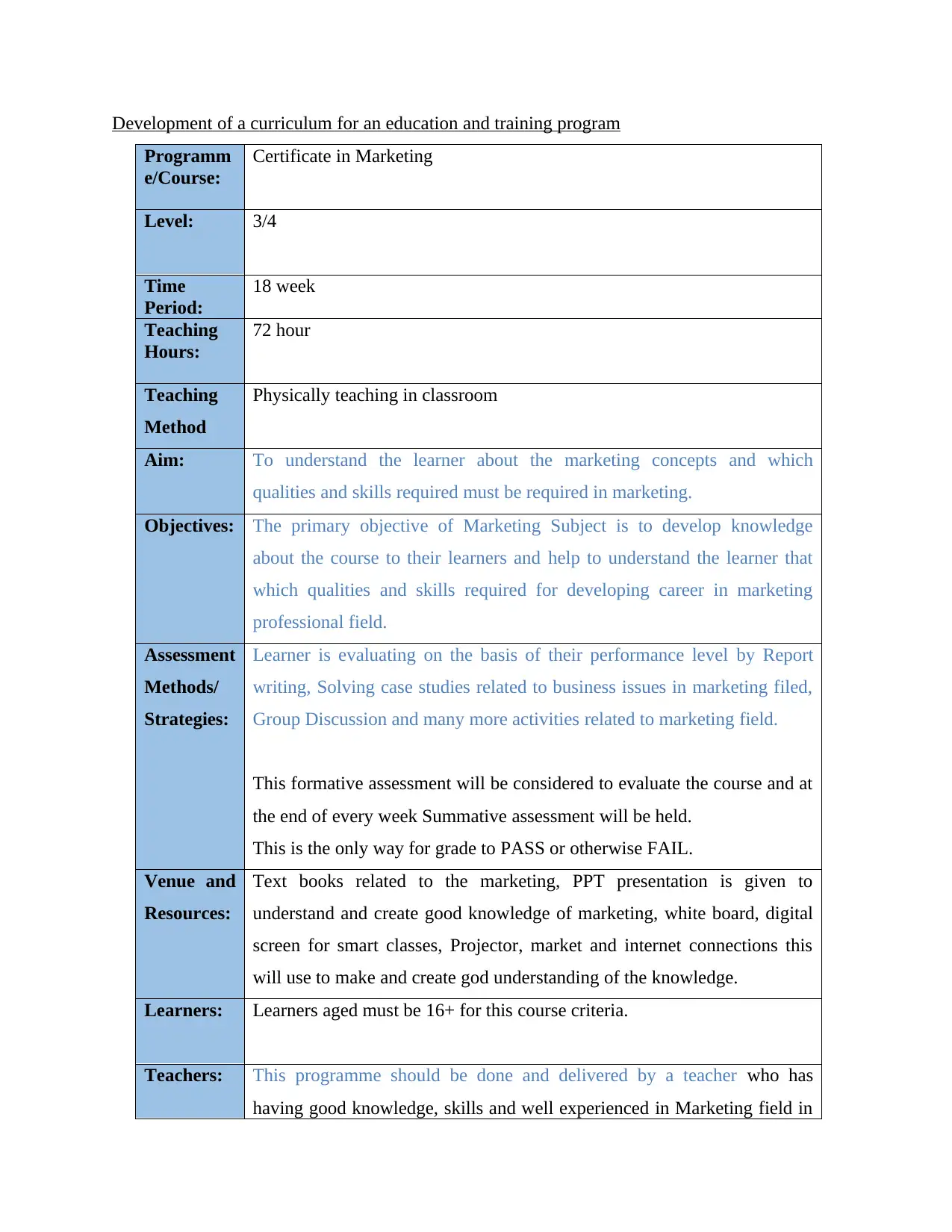
Development of a curriculum for an education and training program
Programm
e/Course:
Certificate in Marketing
Level: 3/4
Time
Period:
18 week
Teaching
Hours:
72 hour
Teaching
Method
Physically teaching in classroom
Aim: To understand the learner about the marketing concepts and which
qualities and skills required must be required in marketing.
Objectives: The primary objective of Marketing Subject is to develop knowledge
about the course to their learners and help to understand the learner that
which qualities and skills required for developing career in marketing
professional field.
Assessment
Methods/
Strategies:
Learner is evaluating on the basis of their performance level by Report
writing, Solving case studies related to business issues in marketing filed,
Group Discussion and many more activities related to marketing field.
This formative assessment will be considered to evaluate the course and at
the end of every week Summative assessment will be held.
This is the only way for grade to PASS or otherwise FAIL.
Venue and
Resources:
Text books related to the marketing, PPT presentation is given to
understand and create good knowledge of marketing, white board, digital
screen for smart classes, Projector, market and internet connections this
will use to make and create god understanding of the knowledge.
Learners: Learners aged must be 16+ for this course criteria.
Teachers: This programme should be done and delivered by a teacher who has
having good knowledge, skills and well experienced in Marketing field in
Programm
e/Course:
Certificate in Marketing
Level: 3/4
Time
Period:
18 week
Teaching
Hours:
72 hour
Teaching
Method
Physically teaching in classroom
Aim: To understand the learner about the marketing concepts and which
qualities and skills required must be required in marketing.
Objectives: The primary objective of Marketing Subject is to develop knowledge
about the course to their learners and help to understand the learner that
which qualities and skills required for developing career in marketing
professional field.
Assessment
Methods/
Strategies:
Learner is evaluating on the basis of their performance level by Report
writing, Solving case studies related to business issues in marketing filed,
Group Discussion and many more activities related to marketing field.
This formative assessment will be considered to evaluate the course and at
the end of every week Summative assessment will be held.
This is the only way for grade to PASS or otherwise FAIL.
Venue and
Resources:
Text books related to the marketing, PPT presentation is given to
understand and create good knowledge of marketing, white board, digital
screen for smart classes, Projector, market and internet connections this
will use to make and create god understanding of the knowledge.
Learners: Learners aged must be 16+ for this course criteria.
Teachers: This programme should be done and delivered by a teacher who has
having good knowledge, skills and well experienced in Marketing field in
Paraphrase This Document
Need a fresh take? Get an instant paraphrase of this document with our AI Paraphraser
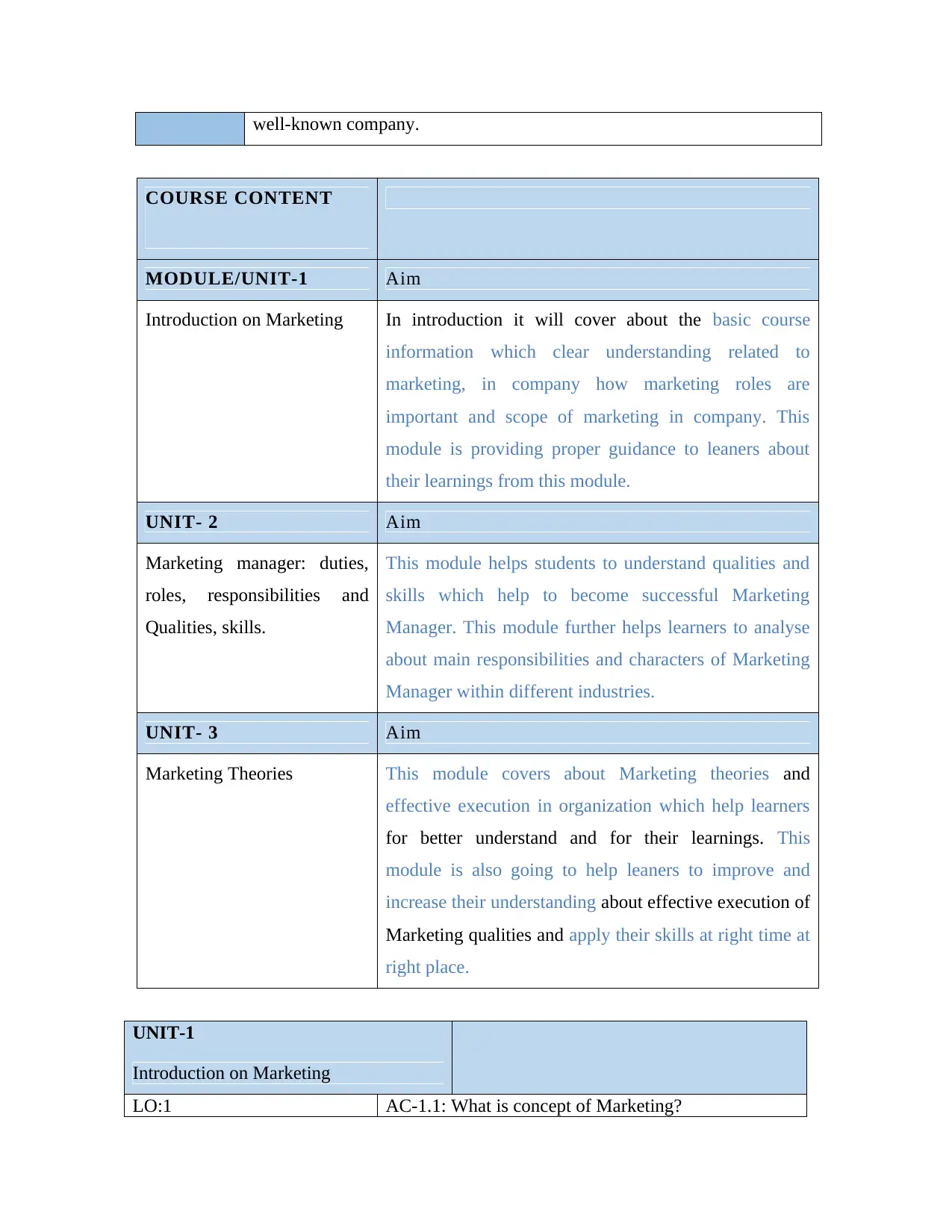
well-known company.
COURSE CONTENT
MODULE/UNIT-1 Aim
Introduction on Marketing In introduction it will cover about the basic course
information which clear understanding related to
marketing, in company how marketing roles are
important and scope of marketing in company. This
module is providing proper guidance to leaners about
their learnings from this module.
UNIT- 2 Aim
Marketing manager: duties,
roles, responsibilities and
Qualities, skills.
This module helps students to understand qualities and
skills which help to become successful Marketing
Manager. This module further helps learners to analyse
about main responsibilities and characters of Marketing
Manager within different industries.
UNIT- 3 Aim
Marketing Theories This module covers about Marketing theories and
effective execution in organization which help learners
for better understand and for their learnings. This
module is also going to help leaners to improve and
increase their understanding about effective execution of
Marketing qualities and apply their skills at right time at
right place.
UNIT-1
Introduction on Marketing
LO:1 AC-1.1: What is concept of Marketing?
COURSE CONTENT
MODULE/UNIT-1 Aim
Introduction on Marketing In introduction it will cover about the basic course
information which clear understanding related to
marketing, in company how marketing roles are
important and scope of marketing in company. This
module is providing proper guidance to leaners about
their learnings from this module.
UNIT- 2 Aim
Marketing manager: duties,
roles, responsibilities and
Qualities, skills.
This module helps students to understand qualities and
skills which help to become successful Marketing
Manager. This module further helps learners to analyse
about main responsibilities and characters of Marketing
Manager within different industries.
UNIT- 3 Aim
Marketing Theories This module covers about Marketing theories and
effective execution in organization which help learners
for better understand and for their learnings. This
module is also going to help leaners to improve and
increase their understanding about effective execution of
Marketing qualities and apply their skills at right time at
right place.
UNIT-1
Introduction on Marketing
LO:1 AC-1.1: What is concept of Marketing?
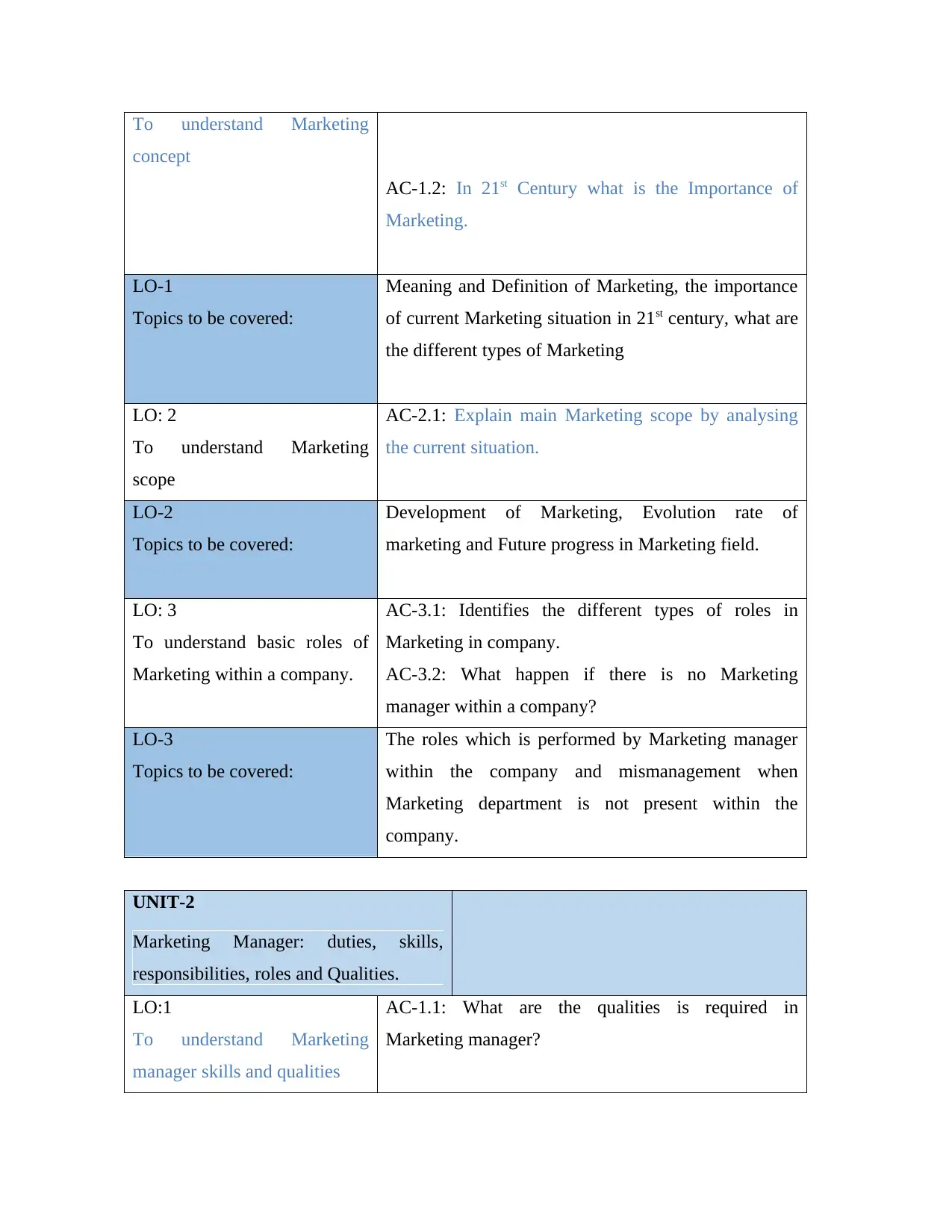
To understand Marketing
concept
AC-1.2: In 21st Century what is the Importance of
Marketing.
LO-1
Topics to be covered:
Meaning and Definition of Marketing, the importance
of current Marketing situation in 21st century, what are
the different types of Marketing
LO: 2
To understand Marketing
scope
AC-2.1: Explain main Marketing scope by analysing
the current situation.
LO-2
Topics to be covered:
Development of Marketing, Evolution rate of
marketing and Future progress in Marketing field.
LO: 3
To understand basic roles of
Marketing within a company.
AC-3.1: Identifies the different types of roles in
Marketing in company.
AC-3.2: What happen if there is no Marketing
manager within a company?
LO-3
Topics to be covered:
The roles which is performed by Marketing manager
within the company and mismanagement when
Marketing department is not present within the
company.
UNIT-2
Marketing Manager: duties, skills,
responsibilities, roles and Qualities.
LO:1
To understand Marketing
manager skills and qualities
AC-1.1: What are the qualities is required in
Marketing manager?
concept
AC-1.2: In 21st Century what is the Importance of
Marketing.
LO-1
Topics to be covered:
Meaning and Definition of Marketing, the importance
of current Marketing situation in 21st century, what are
the different types of Marketing
LO: 2
To understand Marketing
scope
AC-2.1: Explain main Marketing scope by analysing
the current situation.
LO-2
Topics to be covered:
Development of Marketing, Evolution rate of
marketing and Future progress in Marketing field.
LO: 3
To understand basic roles of
Marketing within a company.
AC-3.1: Identifies the different types of roles in
Marketing in company.
AC-3.2: What happen if there is no Marketing
manager within a company?
LO-3
Topics to be covered:
The roles which is performed by Marketing manager
within the company and mismanagement when
Marketing department is not present within the
company.
UNIT-2
Marketing Manager: duties, skills,
responsibilities, roles and Qualities.
LO:1
To understand Marketing
manager skills and qualities
AC-1.1: What are the qualities is required in
Marketing manager?
⊘ This is a preview!⊘
Do you want full access?
Subscribe today to unlock all pages.

Trusted by 1+ million students worldwide
1 out of 32
Related Documents
Your All-in-One AI-Powered Toolkit for Academic Success.
+13062052269
info@desklib.com
Available 24*7 on WhatsApp / Email
![[object Object]](/_next/static/media/star-bottom.7253800d.svg)
Unlock your academic potential
Copyright © 2020–2025 A2Z Services. All Rights Reserved. Developed and managed by ZUCOL.



